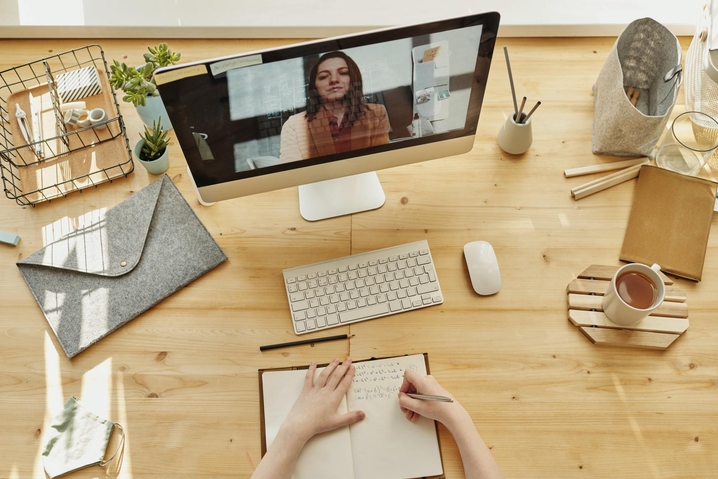
Top 11 tips for acing your video interview in 2021

As the COVID-19 pandemic has led many companies to close their offices and storefronts, many employers and job seekers will soon be experiencing online job interviews for the first time. Video interviews aren’t unheard of—they are often used for remote job interviews—but they are likely to become more common in the coming months.
Recommended links:
- Our collection of 500+ professional resume examples.
- Our gallery of 20+ downloadable resume templates.
This will be jarring for many people, even if they have had lots of experience with in-person interviews. It can be difficult to get used to the experience of staring at a screen instead of a human, and many find that the rhythm of a video conversation can be stilted and strange compared to a face-to-face meeting. Further, you don’t have just your own appearance to worry about; you also need to make sure your equipment is working and your interview space is presentable. Fortunately, this is nothing that can’t be overcome with a little practice and preparation. With these eleven steps you will be well on your way to acing your next video interview.
Test your hardware
The last thing you want to discover on the day of the interview is that your microphone doesn’t work. Be sure to test out your microphone and camera long before the interview so that you will have time to replace them if necessary. It’s also a good idea to use headphones, as relying on your computer’s built-in speakers may result in poor sound quality and loud feedback.
Most modern laptops come with webcams and microphones built in, but if yours does not, you may need to buy or rent external equipment. An external camera and microphone will likely be better quality than the built-in kind, so this may be a blessing in disguise. Of course, if this expense is not acceptable, you can work with what you have. Today’s phones and tablets have far better video and audio quality than they once did, so your iPhone should be good enough for an interview in a pinch.
Get your software ready
You should know what software is being used for your interview before the interview begins, whether it’s Google Hangouts, Skype, Zoom, MS Teams, or some other platform. If you are not familiar with the software, make sure that you have it installed and that all permissions have been granted. You don’t want to spend the first several minutes of the interview making sure the program can access your microphone.
You should also double-check your account settings. Make sure your username is your real name, or at least something acceptably professional. Your picture should also be an appropriate image, ideally a professional headshot that clearly shows your smiling face.
Establish a nice background
You wouldn’t host a business meeting in your kitchen or bedroom, so you shouldn’t attend a video interview there either. Even if your interviewer is impressed by your answers, the fact that they can see your cluttered countertops or laundry in the background will be very distracting. Find a room with a neutral background that allows your interviewer to focus on you, not your furniture and appliances.
Of course, you may not have the option to move to a different room. If that is the case, do your best to make sure the background is neat and tidy, and that there is nothing embarrassing in view. If the camera can’t face a wall, angle the camera so it is looking at your bookshelf (full of industry-related books, of course) or at some tasteful art. This may require placing a desk in the middle of your room so that your camera is facing away from the bed, but you can always rearrange the room back to normal when you’re finished.
Think about framing and lighting
When you FaceTime with your family, you probably don’t think too hard about where the camera is. As long as your face is visible, the camera is doing its job. This is not the case in video interviews. You shouldn’t do the interview while walking around the house, camera swinging around in your outstretched hand, nor should you have your laptop on your lap, camera pointing up your nose. Take the time to place the camera in such a way that you are facing it directly and your features are easy to see.
The best way to frame yourself is to have the camera right at eye-level. This may require placing your laptop on a stack of books, or securing your phone to a tripod. An improvised stand will do fine, as long as it’s stable enough that it won’t tumble to the ground mid-interview!
Another important aspect of looking good on camera is lighting. Diffuse, natural light is generally the most flattering, so if you can, take the interview facing a window. If this is not possible, make sure that the room’s primary light source is in front of you, not behind you. Lights in front of you will illuminate your face, whereas lights behind you will make your face dark and difficult to see. If the lamps in your room aren’t ideally placed, move them for the interview. Placing a couple lamps behind the laptop or on either side of the webcam will give you the complimentary studio lighting you need.
Allow no distractions
It is important to be sure that your interview environment is distraction-free. The interview should not take place in a coffee shop or in a high-traffic area of your house. Any interruption could derail the interview and distract you from the task at hand. Further, interruptions may appear unprofessional, and you are trying to make a good first impression.
Find a quiet room in your house. Close the window to block as much traffic noise as possible. Make sure that everyone who you live with knows that you’re doing an interview, and post a sign on the (closed) door that reminds them not to disturb you. If your roommate has a particularly yappy dog, ask them to take it for a walk for the duration of the interview. Close any apps that you are not using, and set all devices to Do Not Disturb mode so that you don’t get any irritating notifications. Anything you can do to ensure silence is worth doing!
Dress the part
If your interview comes during a stretch of unemployment, you might have fallen out of the habit of dressing for the day, but when the interview comes it’s time to take off your PJs and put on some office-appropriate clothes. Just because the interview takes place in your home doesn’t mean you can dress casually. The old rule of dressing for a job interview still applies: wear clothes one level better than you would have to wear for the job’s day-to-day. Make sure your hair is neat. A tie, a nice blouse, or a blazer can all do wonders for your presentability, and don’t forget the pants—the camera might not show them at first, but you never know if you’ll have to stand up during the interview to grab something you forgot.
Be conscious of your body language
For the most part, your body language should be the same on camera as it is in person. Keep your back straight, smile when appropriate, and try to appear friendly and at-ease. Don’t fidget or make any unnecessary noises—drumming your fingers on the table, even quietly, could be picked up by a laptop mic. If you are in a computer chair, don’t be tempted to swivel back and forth when you’re thinking.
One important thing to remember when on video is to look at the camera when speaking, rather than the monitor. When you look directly at the camera lens, you will appear to your interviewer to be making eye contact. Don’t be tempted to look in the feed at your own face while talking. You can look at the screen when your interviewer is talking, as you want to be able to see their body language and demeanor, but when you are speaking, look at the lens.
Master the mute button
Any sudden noises will be picked up by your microphone. If you have to cough or sneeze, quickly mute your mic so that your interviewer doesn’t get an earful in their headphones. If you are not the one speaking, you can also use the mute button to block unavoidable outside noise, like a truck backing up or a plane overhead (though if you are speaking at the time of the interruption, it may be better to acknowledge the noise and wait until your interviewers are able to hear you again to keep speaking). You should also make sure to mute your microphone if you have to type something, as the click-clacking of keys will be very loud on the other end, but it is better not to type at all—keep your keyboard note-taking to a minimum.
Have your notes and resume ready
As with an in-person interview, you should have your resume and any relevant documents with you when the interview begins. This way, if a question requires you to refer back to a certain item on your resume or a specific portfolio item, you will be able to reach for it without rooting around in your backpack.
One advantage a video interview has over an in-person interview is that you can keep notes nearby relatively inconspicuously. The interviewer can’t see what you are reading, so it is acceptable to have a few more papers on your desk at home than you would typically bring to a face-to-face meeting. This does not mean that you can simply read from a script; it’s just an opportunity to remind yourself of a few key points.
The best way to read from notes without drawing attention is to use sticky notes. By placing sticky notes around your monitor or webcam, you can flick your eyes a few inches to the side to read a note instead of down at your lap. If you do this subtly, the interviewer won’t even notice that you have notes at all. If there is a specific point you want to make, or a particular anecdote that you want to remember, place a sticky note in front of you so you don’t forget.
Practice
Preparing questions and practicing is integral to any successful interview, but there are nuances to a video interview not present in face-to-face meetings. You will be on camera, and it is important to know what you look and sound like on video to ensure that you are making the best possible impression. Fortunately, the presence of the camera also means you can record yourself and review your performance. When you’re practicing your answers to expected interview questions before the interview, record yourself on your webcam, ideally in the same location and clothes that you will use for the real interview. This way, you will be able to watch the recording and preview the acoustics of the room, see how your interview clothes look on camera, and ensure that the lighting and sound quality is good. Keep an eye out for any nervous fidgeting, and make sure you’re making adequate eye contact.
Remember that the standard interview rules still apply
You may not need to practice your handshake, but otherwise the standard rules of a face-to-face interview apply to the video interview as well. Remember to be polite, punctual, and prepared. Research the company beforehand, and be sure that you understand the role that you are applying for. You should have answers ready for any common interview questions, and be ready to give an elevator pitch for your skills and abilities. The interview may seem less formal because it is not in an office, but it will require just as much preparation as a regular interview (if not more).
For more tips on how to make the most of a job interview, check out our article Top 10 Tips for Acing your Job interview.
Video interviews may seem strange to some, but they were on the rise even before the pandemic led to social distancing and increased remote work. Though you might be intimidated at first, if you can master the in-person interview you can master the online interview. Get a head start on your job search by preparing for your next video interview now.

Written By
Ben Temple
Community Success Manager & CV Writing Expert
Ben is a writer, customer success manager and CV writing expert with over 5 years of experience helping job-seekers create their best careers. He believes in the importance of a great resume summary and the power of coffee.

With these 14 tips you'll be ready to ace your next phone interview.
October 17, 2019
Read Post

Community Success Manager & CV Writing Expert

These six tips will have you interviewing for your dream job in no time
November 6, 2019
Read Post

Marketing

Remote careers are on the rise and work from home jobs are more common than ever - there has never been a better time to start working from home.
February 3, 2022
Read Post

Content Manager & Resume Expert
Copyright ©2025 Workstory Inc.